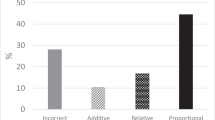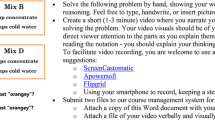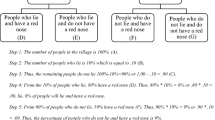Abstract
The purpose of this article is to address the lack of research on teachers’ knowledge of probability. As has been the case in prior research, we asked prospective mathematics teachers to determine which of the presented sequences of coin flips was least likely to occur. However, instead of using the traditional perspectives of heuristic and informal reasoning, we have utilized logical fallacies for our analysis of the results. From this new perspective, we determined that certain individuals’—those who provided normatively incorrect responses—utilized the fallacy of composition when making comparisons of relative likelihood. In addition, we discuss how our findings impact models established in the research literature (e.g., the representativeness heuristic) and, further, we suggest that logical fallacies should supplement heuristic and informal reasoning as potential perspectives for research investigating comparisons of relative likelihood.
Résumé
Le but de cet article est de combler en partie le manque de recherches sur les connaissances des enseignants dans le domaine des probabilités. Comme cela avait été fait dans des études précédentes, nous avons demandé à des futurs enseignants des mathématiques quelle était la moins probable parmi les séquences présentées de tirs à pile ou face. Toutefois, au lieu d’adopter les perspectives traditionnelles du raisonnement heuristique et informel, nous nous sommes servis de sophismes logiques pour analyser les résultats. Dans cette nouvelle perspective, nous avons constaté que certaines personnes—celles qui ont fourni des réponses incorrectes sur le plan normatif—se sont servies de sophismes de composition lorsqu’elles ont comparé les différents niveaux de probabilité. Par ailleurs, nous examinons les façons dont nos résultats peuvent avoir un impact sur les modèles établis dans la recherche actuelle (par exemple l’heuristique de représentativité), et nous proposons que les sophismes logiques soient utilisés pour complémenter le raisonnement heuristique et informel dans la recherche visant à analyser les comparaisons de probabilités relatives.
Similar content being viewed by others
References
Abrahamson, D. (2009). Orchestrating semiotic leaps from tacit to cultural quantitative reasoning—The case of anticipating experimental outcomes of a quasi-binomial random generator. Cognition and Instruction, 27(3), 175–224.
Borovcnik, M., & Bentz, H. (1991). Empirical research in understanding probability. In R. Kapadia & M. Borovcnik (Eds.), Chance encounters: Probability in education (pp. 73–106) Dordrecht, Netherlands: Kluwer.
Chernoff, E. J. (2009). Sample space partitions: An investigative lens. Journal of Mathematical Behavior, 28(1), 19–29.
Chernoff, E. J. (2011). Investigating relative likelihood comparisons of multinomial, contextual sequences. In M. Pytlak, T. Rowland, & E. Swoboda (Eds.), Proceedings of the Seventh Congress of the European Society for Research in Mathematics Education (pp. 755–765) Rzeszów, Poland: University of Rzeszów.
Chernoff, E. J., & Russell, G. L. (2011). An investigation of relative likelihood comparisons: The composition fallacy. In B. Ubuz (Ed), Proceedings of the thirty fifth annual meeting of the International Group for the Psychology of Mathematics Education (Vol. II, pp. 225–232) Ankara, Turkey: Middle East Technical University.
Cox, C., & Mouw, J. T. (1992). Disruption of the representativeness heuristic: Can we be perturbed into using correct probabilistic reasoning? Educational Studies in Mathematics, 23(2), 163–178.
Evans, J. S. B. T., & Pollard, P. (1981). Statistical judgment: A further test of the representativeness heuristic. Acta Psychologica, 51, 91–103.
Hirsch, L. S., & O’Donnell, A. M. (2001). Representativeness in statistical reasoning: Identifying and assessing misconceptions. Journal of Statistics Education, 9(2). Retrieved from http://www.amstat.org/publications/jse/v9n2/hirsch.html
Jones, G. A., Langrall, C. W., & Mooney, E. S. (2007). Research in probability: Responding to classroom realties. In F. K. Lester (Ed), Second handbook of research on mathematics teaching and learning (pp. 909–955) New York, NY: Macmillan.
Kahneman, D., & Tversky, A. (1972). Subjective probability: A judgment of representativeness. Cognitive Psychology, 3, 430–454.
Konold, C. (1989). Informal conceptions of probability. Cognition and Instruction, 6(1), 59–98.
Konold, C., Pollatsek, A., Well, A., Lohmeier, J., & Lipson, A. (1993). Inconsistencies in students’ reasoning about probability. Journal for Research in Mathematics Education, 24(5), 392–414.
Kunda, Z., & Nisbett, R. E. (1986). Prediction and partial understanding of the law of large numbers. Journal of Experimental Social Psychology, 22(4), 339–354.
Lecoutre, M.-P. (1992). Cognitive models and problem spaces in “purely random” situations. Educational Studies in Mathematics, 23(6), 557–569.
Olson, C. (1976). Some apparent violations of the representativeness heuristic in human judgment. Journal of Experimental Psychology: Human Perception and Performance, 2(4), 599–601.
Rubel, L. H. (2006). Students’ probabilistic thinking revealed: The case of coin tosses. In G. F. Burrill & P. C. Elliott (Eds.), Thinking and reasoning with data and chance: Sixty-eighth yearbook (pp. 49–60) Reston, VA: National Council of Teachers of Mathematics.
Shaughnessy, J. M. (1977). Misconceptions of probability: An experiment with a small-group, activity-based, model building approach to introductory probability at the college level. Educational Studies in Mathematics, 8, 285–316.
Stohl, H. (2005). Probability in teacher education and development. In G. A. Jones (Ed), Exploring probability in school: Challenges for teaching and learning (pp. 345–366) New York, NY: Springer.
Tversky, A., & Kahneman, D. (1971). Belief in the law of small number. Psychological Bulletin, 76, 105–110.
Tversky, A., & Kahneman, D. (1974). Judgment under uncertainty: Heuristics and biases. Science, 185, 1124–1131.
Watson, J. M., Collis, K. F., & Moritz, J. B. (1997). The development of chance measurement. Mathematics Education Research Journal, 9, 60–82.
Author information
Authors and Affiliations
Corresponding author
Rights and permissions
About this article
Cite this article
Chernoff, E.J., Russell, G.L. The Fallacy of Composition: Prospective Mathematics Teachers’ Use of Logical Fallacies. Can J Sci Math Techn 12, 259–271 (2012). https://doi.org/10.1080/14926156.2012.704128
Published:
Issue Date:
DOI: https://doi.org/10.1080/14926156.2012.704128




